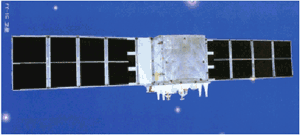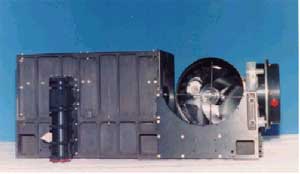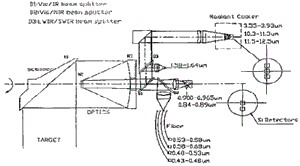| GISdevelopment.net ---> AARS ---> ACRS 1999 ---> Poster Session 6 |
The FY-1C Meteorological
Satellite and Its Remote Sensor
Gong Huixing, Zheng Qinbo,
Weng Chuijun
Shanghai Institute of Technical Physics,
Chinese Academy of Sciences, Shanghai, China (200083)
IntroductionShanghai Institute of Technical Physics,
Chinese Academy of Sciences, Shanghai, China (200083)
China successfully launched the FY-1C Meteorological Satellite from Taiyuan Satellite Launch Center by the CZ-4B carrier rocket at 09:33 (Beijing time) on May 10th, 1999. The satellite is placed in a sun-synchronous orbit at an altitude of 862.8 km with an inclination of 98.8°, an eccentricity of 0.009, at descending local time of 08:34 and with a period of 102.23 min.
China once launched two sun-synchronous orbit meteorological satellites FY-1A and FY-1B in 1988 and 1990 respectively. Because the satellite attitude was out of control, neither satellite had achieved its predetermined lifetime. In order to enhance the earth observation ability of satellite and establish China's own operational system of meteorological satellite, China decided to continue developing the sun-synchronous orbit meteorological satellite. Compared to FY-1A and FY-1B, FY-1C has made the following improvements:
- Improve the reliability of satellite, and the designed lifetime is increased from one year to two years;
- The record capacity for image data onboard is increased from 60 min to 300 min, so as to acquire the global image data;
- The number of detecting bands of visible and infrared scanning radiometer is increased from 5 to 10.
- Continuously observe the global atmosphere and surface scenes with the 10-band scanning radiometer;
- Conduct remoter sensing experiments of ocean color;
- Utilize the satellite ground stations in China to receive the image data played back from satellite, and acquire the global cloud images with a ground resolution of 3.1 km and the ocean surface temperature images or 10 band images of any region on the earth with a ground resolution of 1.1 km once a day.
Fig.1 shows the FY-1C satellite with a dimension of 2.02×2.00×10.5m and a weight of 954 Kg. There are four solar cell plates with a total area of 9.58m2 on both sides of the satellite. They provide the satellite with an average power consumption of about 250 W. The satellite attitude is three-axis stabilized and the deviation is less than 0.4° . On its side facing the ground, two 10-channel scanning radiometers which are redundant each other are mounted. The image signals are processed onboard in real time, resulting in 10 channel digital signals with a ground resolution of 1.1 km and data rate of 1.3308 Mbps to be transmitted to the ground by a HRPT transmitter at a transmission frequency of 1700.4 MHz, and 4 channel digital image signals which have undergone scanning geometric distortion correction with a ground resolution of 3.1 km and data rate of 88.72 kbps to be recorded on the onboard solid-state storage. When the satellite enters the receiving range of the ground stations in China, the stored data are played back at a data rate of 1.3308 Mbps and a record-play ratio of 1:15.
Because the number of detecting channels of the scanning radiometer on FY-1C is 4 more than that of the AVHRR on NOAA satellite and the channel number for transmission in real time on FY-1C is doubled. Therefore, the ground stations for NOAA satellite must be improved so as to be able to receive the real-time image data transmitted from the FY-1C satellite.

Fig.1 FY-1C satellite.
Remote Sensor
The 10-channel scanning radiometer is the main instrument of the FY-1C satellite. It is shown in Fig.2 and its optical configuration is shown in Fig.3. By means of the rotation of a 45° mirror of the scanning radiometer and the motion of the satellite round the earth, the two-dimensional scene of the earth is observed.
The rotation rate of the scanning mirror is 360 rpm. The aperture of the optical system is 200 mm. The bands for 10 detecting channels are limited by the filters located in front of detectors. The detectors for visible and near infrared channels are Si and those for short wavelength infrared channels are PV-type HgCdTe operating at room temperature. Three thermal infrared detectors are all PC-type HgCdTe operating at 105 K, cooled by a radiant cooler.
The 10-channel scanning radiometer was developed on the basis of the 5-channel scanning radiometers for FY-1A and FY-1B. Its 10 channels are listed in table 1. (Compared with the AVHRR on NOAA satellite, three visible channels and one near infrared channel are added, which are used for the detection of ocean chlorophyll, ocean suspended sediment, and water vapor content in atmosphere, respectively.)

Fig.2 The scanning radiometer.

Fig.3 The optical configuration of the scanning radiometer.
Among them, 0.58-0.68mm band is used to take visible cloud images. The 0.84-0.89mm band has a high atmosphere transmittance and it is used for the atmospheric radiation correction of visible and near infrared channels and is also used to monitor vegetation index together with the 0.58-0.68 band. Channel 3 is sensitive to high temperature objects, so it is used to monitor forest and grassland fire. The thermal infrared split window bands of 10.3-11.3mm and 11.5-12.5mm are used to measure ocean surface and land surface temperatures. In 1.58-1.64mm band, the reflectance is reduced when the water content in soil is increased. So this band is used to detect the moisture of soil. The reflectance of snow is reduced as the wavelength is increased. In 1.58-1.64mm band, the reflectance of snow is less than 25%. So the images of this band together with the visible cloud images are used to discriminate cloud and snow. Channels 7, 8 and 9 are used to monitor the ocean chlorophyll and suspended sediment. The transmittance of channel 10 is influenced by water vapor, so this channel and channel 2 can be used to monitor the water vapor content in atmosphere.
Table 1. The detection bands of 10-channel scanning radiometer
| Serial number | Detection band (mm) | Objects | FY-1A,B 5-channel scanning radiometer | NOAA AVHRR |
| 1 | 0.58-0.68 | Cloud, vegetation | Ö | Ö |
| 2 | 0.84-0.89 | Vegetation, atmospheric correction | 0.725-1.1mm | 0.725-1.1 mm |
| 3 | 3.55-3.93 | Fire and night temperature | Ö | |
| 4 | 10.3-11.3 | Ocean surface and land surface temperature | 10.5-12.5 mm | Ö |
| 5 | 11.5-12.5 | Ocean surface and land surface temperature | Ö | |
| 6 | 1.58-1.64 | Crop water content and soil moisture | Ö | |
| 7 | 0.43-0.48 | Ocean water color | ||
| 8 | 0.48-0.53 | Ocean water color | Ö | |
| 9 | 0.53-0.58 | Ocean water color | Ö | |
| 10 | 0.900-0.965 | Vapor content |
Table 2 lists the main specifications of the 10-channel scanning radiometer. The ten detecting channels all have a spatial resolution of 1.26mr and an effective scanning observing angle of ± 55.4° on both sides of the nadir, corresponding to the arc length of 3100 km on earth surface. Its global coverage period is 24 hr. The user's test from June to July shows that the sensitivity of the visible and near-infrared channels are better than 3.5×10 -4 , the NED rof the short wavelength IR channel is 1.1×10 -3 , the NEDT of three thermal IR channels is less than 0.27 K . Because a reference blackbody is mounted and the cold space is used as a zero radiation reference, the radiation calibration reaches an accuracy of 1.0 K.
Operation in orbit
The FY-1C satellite was launched into the predetermined orbit at 09:45 am on May 10th, 1999, and the scanning radiometer began to operate at 11:16 am, the ground station received the image signals from four visible bands, three near infrared bands and one short wavelength infrared band at once. The radiant cooler began to cool on June 9th after the heating for outgassing for about one month. On June 10th, the temperature of the cooler's patch reached 105 K, three infrared channels were switched on, all of ten channels of the scanning radiometer operated. The image data of FY-1C satellite are being applied in weather forecast, flood monitoring, vegetation index estimation, observation of ocean chlorophyll and suspended sediment and monitoring of the global weather and ocean temperature and etc.
Table 2. Main specifications of the 10-channel scanning radiometer
| Parameters | Measured specifications |
| IFOV | 1.26mr |
| Ground resolution of image | 1.1 km |
| Swath width | 3100 km |
| Effective view angle | ±55.4° |
| Scanning rate | 360 rpm |
| Number of detecting channels | 10 |
| Detectors | Si (channels 1, 2, 7, 8, 9,
10) HgCdTe (channels 6, operating at room temperature) |
| Cooling method | Radiant cooling, 105 K |
| Detection sensitivity | NED
r£3×10-4 (channels 1, 2, 7, 8, 9, 10) NED r£1×10 -3 (channel 6) NEDT£0.27K(channel 3) NEDT£0.25K(channel 4, 5) |
| Radiation calibration accuracy | Better than 10% for visible and IR
channels; 1.0 K for IR channels |
| Data quantization | 10 bit |
| Data rate | 1.3308 Mbps |
| Weight | 53.5 Kg |
| Power consumption | 43.5 W |
Up to now, the FY-1C satellite has been operating normally in orbit for more than four months. We hope it to continue its stable operation so as to reach its expected lifetime of two years.
In 2001, China will launch its meteorological satellite FY-1D to replace the FY-1C satellite.